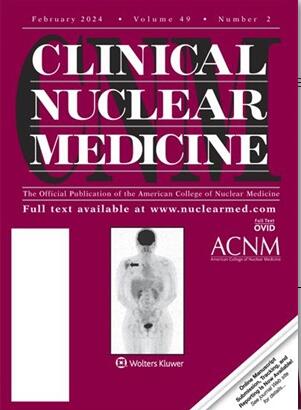生长激素分泌型垂体腺瘤的68Ga- DOTATOC PET/CT、18F-FDOPA和18F-FDG PET/MR表现
IF 9.6
3区 医学
Q1 RADIOLOGY, NUCLEAR MEDICINE & MEDICAL IMAGING
Clinical Nuclear Medicine
Pub Date : 2025-10-01
Epub Date: 2025-06-30
DOI:10.1097/RLU.0000000000005937
引用次数: 0
摘要
肢端肥大症是一种罕见的疾病,通常由生长激素分泌垂体腺瘤(GHPA)引起,神经影像学在肿瘤定位、特征和手术计划中起着重要作用。一名57岁男性因胰腺偶发病变行68Ga-DOTATOC PET/CT检查。PET显示放射示踪剂摄取增加,脑垂体肿大。18F-FDOPA和18F-FDG PET/MRI显示鞍区病变提示垂体腺瘤。切除肿瘤的病理检查证实为GHPA。本文章由计算机程序翻译,如有差异,请以英文原文为准。
68 Ga- DOTATOC PET/CT, 18 F-FDOPA, and 18 F-FDG PET/MR Findings in Growth Hormone-secreting Pituitary Adenoma.
Acromegaly is a rare disease frequently caused by a growth hormone-secreting pituitary adenoma (GHPA), and neuroimaging plays an important role in tumor localization, characterization, and surgical planning. A 57-year-old man underwent 68 Ga-DOTATOC PET/CT for an incidental pancreatic lesion. The PET revealed an increased radiotracer uptake and enlargement of the pituitary gland. The study was completed with 18 F-FDOPA and 18 F-FDG PET/MRI, which revealed a sellar lesion suggesting pituitary adenoma. Pathological examination of the resected tumor confirmed a GHPA.
求助全文
通过发布文献求助,成功后即可免费获取论文全文。
去求助
来源期刊

Clinical Nuclear Medicine
医学-核医学
CiteScore
2.90
自引率
31.10%
发文量
1113
审稿时长
2 months
期刊介绍:
Clinical Nuclear Medicine is a comprehensive and current resource for professionals in the field of nuclear medicine. It caters to both generalists and specialists, offering valuable insights on how to effectively apply nuclear medicine techniques in various clinical scenarios. With a focus on timely dissemination of information, this journal covers the latest developments that impact all aspects of the specialty.
Geared towards practitioners, Clinical Nuclear Medicine is the ultimate practice-oriented publication in the field of nuclear imaging. Its informative articles are complemented by numerous illustrations that demonstrate how physicians can seamlessly integrate the knowledge gained into their everyday practice.
 求助内容:
求助内容: 应助结果提醒方式:
应助结果提醒方式:


